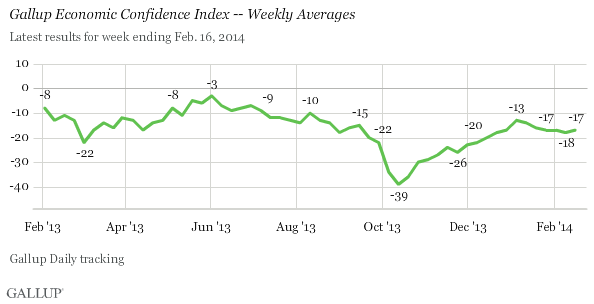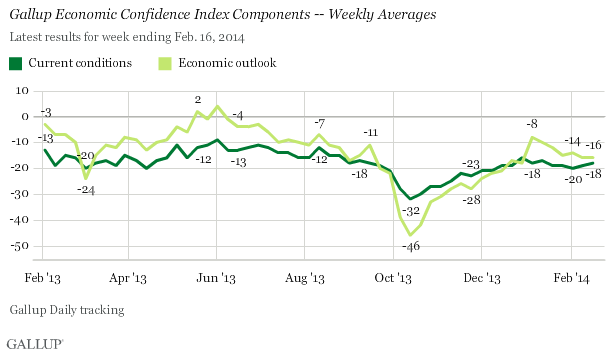WASHINGTON, D.C. -- Gallup's Economic Confidence Index was -17 for the week ending Feb. 16, similar to the -18 of the previous week. Americans' confidence in the economy has held steady in recent weeks, despite a discouraging January for the stock market, but improved late last week, after the sharp uptick in the Dow Jones industrial average and Standard & Poor's 500 index.

Economic confidence dropped substantially in October amid the federal government shutdown, but has recovered gradually in the months since, reaching a recent weekly high of -13 in early January.
The Gallup Economic Confidence Index is the average of two components: Americans' views on current economic conditions in the U.S. and their perceptions of whether the economy is getting better or worse.
Last week, 40% of Americans said the economy is getting better, while 56% believed it is getting worse. This resulted in a net economic outlook score of -16, the same as the previous week.
Meanwhile, 19% of Americans rated current economic conditions "excellent" or "good," and 37% rated them "poor." This resulted in a net current conditions score of -18, within the -17 to -20 range seen since the beginning of 2014.

Implications
Though Gallup's Economic Confidence Index remains in negative territory and has been stable in recent weeks, it could improve with the promising pace of the Dow through mid-February.
The Dow last month had its worst January in five years, but February has been a higher-performing month so far, with a 127-point jump on Valentine's Day.
Survey Methods
Results for this Gallup poll are based on telephone interviews conducted Feb. 10-16, 2014, on the Gallup Daily tracking survey, with a random sample of 3,539 adults, aged 18 and older, living in all 50 U.S. states and the District of Columbia.
For results based on the total sample of national adults, the margin of sampling error is ±3 percentage points at the 95% confidence level.
Interviews are conducted with respondents on landline telephones and cellular phones, with interviews conducted in Spanish for respondents who are primarily Spanish-speaking. Each sample of national adults includes a minimum quota of 50% cellphone respondents and 50% landline respondents, with additional minimum quotas by region. Landline telephone numbers are chosen at random among listed telephone numbers. Cellphone numbers are selected using random-digit-dial methods. Landline respondents are chosen at random within each household on the basis of which member had the most recent birthday.
Samples are weighted to correct for unequal selection probability, nonresponse, and double coverage of landline and cell users in the two sampling frames. They are also weighted to match the national demographics of gender, age, race, Hispanic ethnicity, education, region, population density, and phone status (cellphone only/landline only/both, cellphone mostly, and having an unlisted landline number). Demographic weighting targets are based on the most recent Current Population Survey figures for the aged 18 and older U.S. population. Phone status targets are based on the most recent National Health Interview Survey. Population density targets are based on the most recent U.S. census. All reported margins of sampling error include the computed design effects for weighting.
In addition to sampling error, question wording and practical difficulties in conducting surveys can introduce error or bias into the findings of public opinion polls.
For more details on Gallup's polling methodology, visit www.gallup.com.
